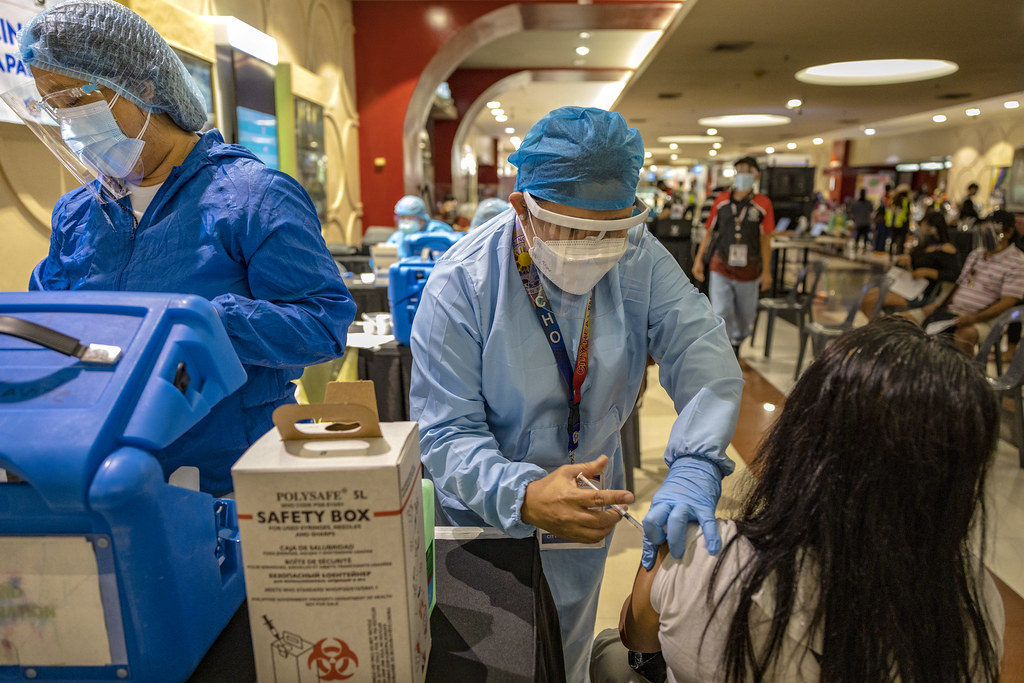Photo: News_Covid_1: Woman receiving dose of Moderna Covid-19 vaccine via flickr
The first cases of Coronavirus Disease 2019 (COVID-19) were recorded in December 2019, in Wuhan, China. Three months later, on March 11, 2020, after recording over 118,000 cases and 4,291 deaths globally, the World Health Organization (WHO) declared COVID-19 a pandemic. Although COVID-19’s impact on daily life has loosened and no longer holds pandemic status, its ramifications continue to afflict the world economy, individual health, the climate, scientific research, global and national politics, societal health and overall quality of life.
COVID’s Possible Origin
Several theories regarding the origin of COVID have been circulating. According to the New England Journal of Medicine, the two most plausible theories are a zoonotic spillover from a seafood market and a laboratory leak from the Wuhan Institute of Virology. Although no decisive consensus has been reached, the same article in the New England Journal of Medicine and a report by the journal Nature point to a zoonotic origin in the Huanan Seafood Wholesale Market as the most likely origin.
Recorded Cases & Deaths
According to the WHO, there have been approximately 774 million reported COVID-19 cases and over seven million deaths worldwide, as of Jan. 14, 2024. In the United States, the WHO reported 103 million cases, while the CDC reported 1.172 million deaths, the most of any country for both metrics. According to USAFacts, Pennsylvania has so far reported 3.5 million cases and suffered 51,344 deaths, while Chester County has reported 118,990 cases and suffered 1,362 deaths. It’s likely that these figures are underreported due at-home cases that cases that were never documented, according to CNN.
Economic Impact
A team of researchers and experts from the University of Southern California valued the total economic setback of COVID on the US economy between January 2020 and December 2023 at $14 trillion. This figure factors in productivity lost due to quarantine mandates, deaths, business closures, lost sales revenue, layoffs and individual behavioral changes. The air travel sector was the most adversely affected.
However, not everyone lost out. The pandemic was profitable for the healthcare sector. For example, Pfizer’s annual net income more than doubled to $21.9 billion in 2021 from $9.2 billion in 2020. Another group of pandemic beneficiaries were billionaires. According to Oxfam, during the first two years of the pandemic, the 10 richest men in the world saw their net worth increase from $700 billion to $1.5 trillion, while 99% of humanity saw its income fall.
Weaponization of COVID
The pandemic brought a wave of unprecedented distress and confusion for most people. In an ABC news article, the Department of Homeland Security warned that, “Violent extremists probably are seeking to exploit public fears associated with the spread of COVID-19 to incite violence, intimidate targets and promote their ideologies.”
East Asians, in particular, faced worldwide condemnation. In the US, former President Donald Trump was eager to draw racist connections between COVID and people of Chinese descent, referring to the virus as the “Chinese virus” and the “kung flu,” which perpetuated dangerous stigmas, polarization and scapegoating, give comfort to racists and exacerbated already prevalent anti-Asian hate crimes. One instance where Anti-Asian hate manifested itself occurred on March 14, 2020, when an Asian American family in Texas was the target of a stabbing because their assailant thought they were spreading COVID based on their race.
Mental health impact
Factors such as lockdowns, social isolation, uncertainty, fear, grief and economic recession all contributed to a rise in mental health problems. The WHO released a scientific brief which revealed that anxiety and depression rates surged by 25 percent globally.
Impact on Education
The Brookings Institution described COVID’s impact on education as “devastating.” They go on to link staff shortages, school closures and quarantines to the deterioration in quality of learning. The National Library of Medicine stated that remote learning was also responsible for the decline because it prevented nurturing forms of communication and engagement between instructors and students.
According to The 74, older students are most at risk of educational setbacks since they have fewer years remaining in school to catch up on lost learning.
Due to these setbacks, the Northwest Evaluation Association, a non-profit organization that creates academic assessments for students pre-K-12, reported that, “the average student will require 4.1 months of additional schooling to catch up to pre-COVID levels in reading and 4.5 months in math.”
Conclusion
On May 5, 2023, the WHO declared an end to COVID-19’s pandemic status, followed by several US agencies on May 11. Despite the formal end to the pandemic, its impact on humanity has not fully receded. Its effects on the world economy, mental health and politics may persist for decades to come.
Sameh Sharoud is a third-year Psychology major with a minor in Biology. SS1015422@wcupa.edu

